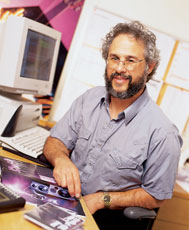 By Steve Oppenheimer
By Steve Oppenheimer
(September 1998)
A friend who works in our Emeryville, California, enclave recently recorded a single in Nashville. A former resident of Music City, he used his connections to employ the services of some virtuoso players. When he dropped a few names, my jaw dropped. My jaw dropped farther when I heard that one famous player declined the gig on the sole grounds that the tracks would be recorded to ADAT! Apparently, this musical wizard believes that acoustic stringed instruments should be tracked only to analog tape.
This artist may be a bright fellow, but in turning down a session on these grounds, he is thinking like a neo-Luddite. Using analog tape is not the only way to get a warm, natural sound when recording acoustic instruments. Many producers and engineers who record digitally simply add analog warmth with a tube processor; in fact, I happen to know that the engineer for this record did so.
You could argue that the first round of ADATs, for all its success, had room for sonic improvement. Alesis apparently agreed: it issued the improved ADAT-XT, which recorded 16-bit audio via 18-bit converters, and now is shipping a new generation of machines that record 20-bit audio to tape (see the review of the ADAT LX20 and XT20 on p. 138). These improved machines can capture the sound of our neo-Luddite’s instrument far more faithfully than can an analog deck.
Thanks to the development of DVD, the Next Big Thing is said to be 24-bit, 96 kHz digital audio. Indeed, the better “wide and fast” converters I’ve heard sound awesome! Several 24-bit products are available now, though not all support 96 kHZ sampling; for example, Ensoniq’s PARIS hard-disk recorder (reviewed on p. 122) supports 24-bit, 48 kHz recording.
But wait a minute! Whenever you increase the bit resolution and sampling rate, there are tradeoffs, such as increased file size and computer-memory requirements and potential throughput bottlenecks. Furthermore, DVD also supports 20-bit, 48 kHz audio, which sounds excellent and has more moderate file sizes. So 20/48 might be a smarter choice than 24/96 for many purposes.
Even as 96 kHz converters hit the market, 192 kHz recording is on the horizon. Several EM and Mix editors recently attended an informal demo by converter manufacturer dCS, comparing 24-bit recordings captured at 44.1, 48, 96, and 192 kHz. We agreed that, compared to 96 kHz recordings, the 192 kHz recordings were airier, more natural-sounding, and exhibited superior imaging. There are good technical reasons for this, which is another story. But we were listening to 24/192 playback; it’s fair to wonder whether consumers will notice the difference, even with 24/96 DVD and an audiophile home-theater system. Furthermore, we’re talking about files that are three times the size of 16-bit, 48 kHz files! If you mix multichannel surround at 24/96 or higher, the files will be absolutely gigantic.
Given these tradeoffs, what constitutes “good enough”? With 20-bit, 48 kHz technology, which is commonly available, our virtuoso neo-Luddite and his ilk can hear their instruments with unprecedented sound quality-if they open their ears and minds. At the same time, before we give in to unfettered 24/96 technolust, let’s examine the practical considerations a bit more.